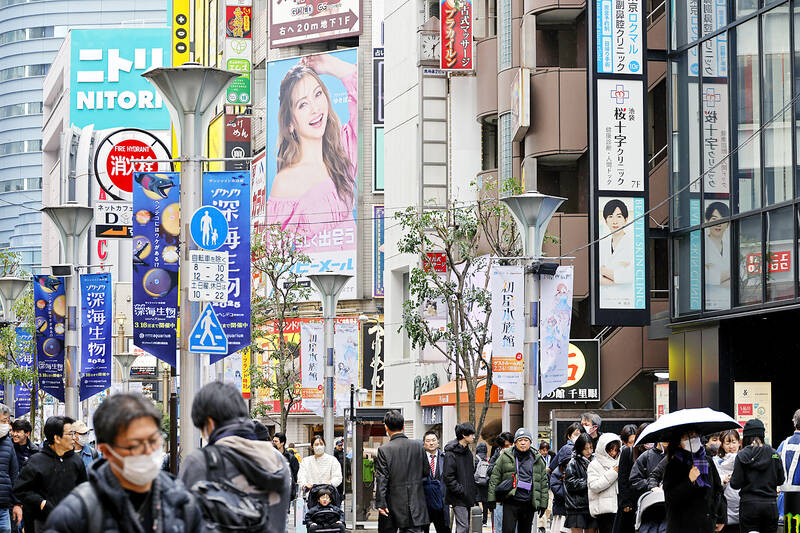Japan’s economy grew at a better-than-expected annual rate of 2.8 percent in the October-to-December quarter last year, underlined by steady exports and moderate consumption.
On a quarter-to-quarter basis, the world’s fourth-largest economy grew 0.7 percent for its third straight quarter of growth, the Japanese Cabinet Office reported yesterday in its preliminary data.
The fourth-quarter figure was more than double market expectations of 0.3 percent growth.

Photo: EPA-EFE
For the whole of last year, the Japanese economy eked out 0.1 percent growth in seasonally adjusted real GDP, the fourth straight year of expansion but down from 1.5 percent the year before, the data showed.
Private consumption grew at an annual rate of 0.5 percent during the three months through December, holding up while losing momentum. Exports jumped 4.3 percent, and capital investment increased 0.5 percent.
Some analysts think the anticipation of US President Donald Trump’s tariffs might have lifted trade.
Unlike the US and some other nations, Japan has been dogged by deflation, and these lower prices stifle growth. However, recent wage growth has kept deflationary trends in check.
Recent data show inflation is at about the Bank of Japan’s target of 2 percent. Higher prices are crimping consumer spending, which makes up for more than half the economy.
The central bank might move to further raise interest rates, which were at zero or below zero for years to wrest the economy out of deflation. It raised its key interest rate to about 0.5 percent from 0.25 percent last month, saying that inflation is holding at a desirable target level. The next monetary policy meeting is next month.
“Stronger growth may reinforce expectations for the Bank of Japan to push through with further hikes, while the slowdown in private consumption growth may be addressed by the prospects of higher wages ahead,” IG Asia Pte market strategist Yeap Jun Rong (葉俊榮) said.

CHIP RACE: Three years of overbroad export controls drove foreign competitors to pursue their own AI chips, and ‘cost US taxpayers billions of dollars,’ Nvidia said China has figured out the US strategy for allowing it to buy Nvidia Corp’s H200s and is rejecting the artificial intelligence (AI) chip in favor of domestically developed semiconductors, White House AI adviser David Sacks said, citing news reports. US President Donald Trump on Monday said that he would allow shipments of Nvidia’s H200 chips to China, part of an administration effort backed by Sacks to challenge Chinese tech champions such as Huawei Technologies Co (華為) by bringing US competition to their home market. On Friday, Sacks signaled that he was uncertain about whether that approach would work. “They’re rejecting our chips,” Sacks

Taiwan’s exports soared 56 percent year-on-year to an all-time high of US$64.05 billion last month, propelled by surging global demand for artificial intelligence (AI), high-performance computing and cloud service infrastructure, the Ministry of Finance said yesterday. Department of Statistics Director-General Beatrice Tsai (蔡美娜) called the figure an unexpected upside surprise, citing a wave of technology orders from overseas customers alongside the usual year-end shopping season for technology products. Growth is likely to remain strong this month, she said, projecting a 40 percent to 45 percent expansion on an annual basis. The outperformance could prompt the Directorate-General of Budget, Accounting and

NATIONAL SECURITY: Intel’s testing of ACM tools despite US government control ‘highlights egregious gaps in US technology protection policies,’ a former official said Chipmaker Intel Corp has tested chipmaking tools this year from a toolmaker with deep roots in China and two overseas units that were targeted by US sanctions, according to two sources with direct knowledge of the matter. Intel, which fended off calls for its CEO’s resignation from US President Donald Trump in August over his alleged ties to China, got the tools from ACM Research Inc, a Fremont, California-based producer of chipmaking equipment. Two of ACM’s units, based in Shanghai and South Korea, were among a number of firms barred last year from receiving US technology over claims they have

BARRIERS: Gudeng’s chairman said it was unlikely that the US could replicate Taiwan’s science parks in Arizona, given its strict immigration policies and cultural differences Gudeng Precision Industrial Co (家登), which supplies wafer pods to the world’s major semiconductor firms, yesterday said it is in no rush to set up production in the US due to high costs. The company supplies its customers through a warehouse in Arizona jointly operated by TSS Holdings Ltd (德鑫控股), a joint holding of Gudeng and 17 Taiwanese firms in the semiconductor supply chain, including specialty plastic compounds producer Nytex Composites Co (耐特) and automated material handling system supplier Symtek Automation Asia Co (迅得). While the company has long been exploring the feasibility of setting up production in the US to address